HOME / WHITEPAPER
Page last updated: November 15, 2022
Outdefine's Whitepaper
Abstract
As we move into an era of technological advancements and comfortability in remote work, the common career path of going to school and entering the corporate world is becoming less of a theme. Nowadays, it's crucial for employers to be able to efficiently hire trustworthy employees. The lack of a physical presence and daily management oversight highlights the need for a vetting system, records, and reviews for contractual employees.
As opposed to a centralized authority that lacks transparency and capitalizes on other people's work and development, a decentralized economy allows people to govern together, trade services, and benefit from progress. The success and growth of the community and others is the essence of a decentralized authority, which creates a healthy and thriving ecosystem.
Outdefine is a decentralized talent community connecting the world's leading web3 talent with freelance opportunities globally. With Outdefine, you can find a talent-focused community that goes beyond traditional hiring networks. The community is a decentralized autonomous organization (DAO) that is managed by members without the influence of a central authority. Talent and hiring professionals can become shareholders by earning token rewards based on activity, impact, and contributions within the community. The community and its native token will run on the Polygon blockchain with ability to manage token allocation, staking, and governance. The talent-first values of the community are meant to boost growth and reward early and active members. The Outdefine community will not only reward active talent, but will also build an ecosystem via community led webinars, events, incubators, and bootcamps.
1. The Trends
1.1 Technological
The internet has been transformed from Web 1.0 “read only” to Web 2.0 “read, write, participate”, and now to Web 3.0 “read, write, own”. The ownership is typically represented by a cryptocurrency or a token on the blockchain. For example, Reddit, a Web 2.0 community, recently evolved to Web 3.0 by developing crypto tokens to reward its community contributors. More interestingly, Reddit has launched its NFT marketplace by teaming up with Polygon and achieving $2.5 million daily transactions almost instantly.
Although still in its infancy, blockchain technology is growing at an exponential rate. We are seeing a rapid uptake in the amount of research papers, consensus protocols, blockchain transactions, and zero-knowledge proof constructs. Given these upward trends, the industry is in high demand for expert talent to implement and execute them.
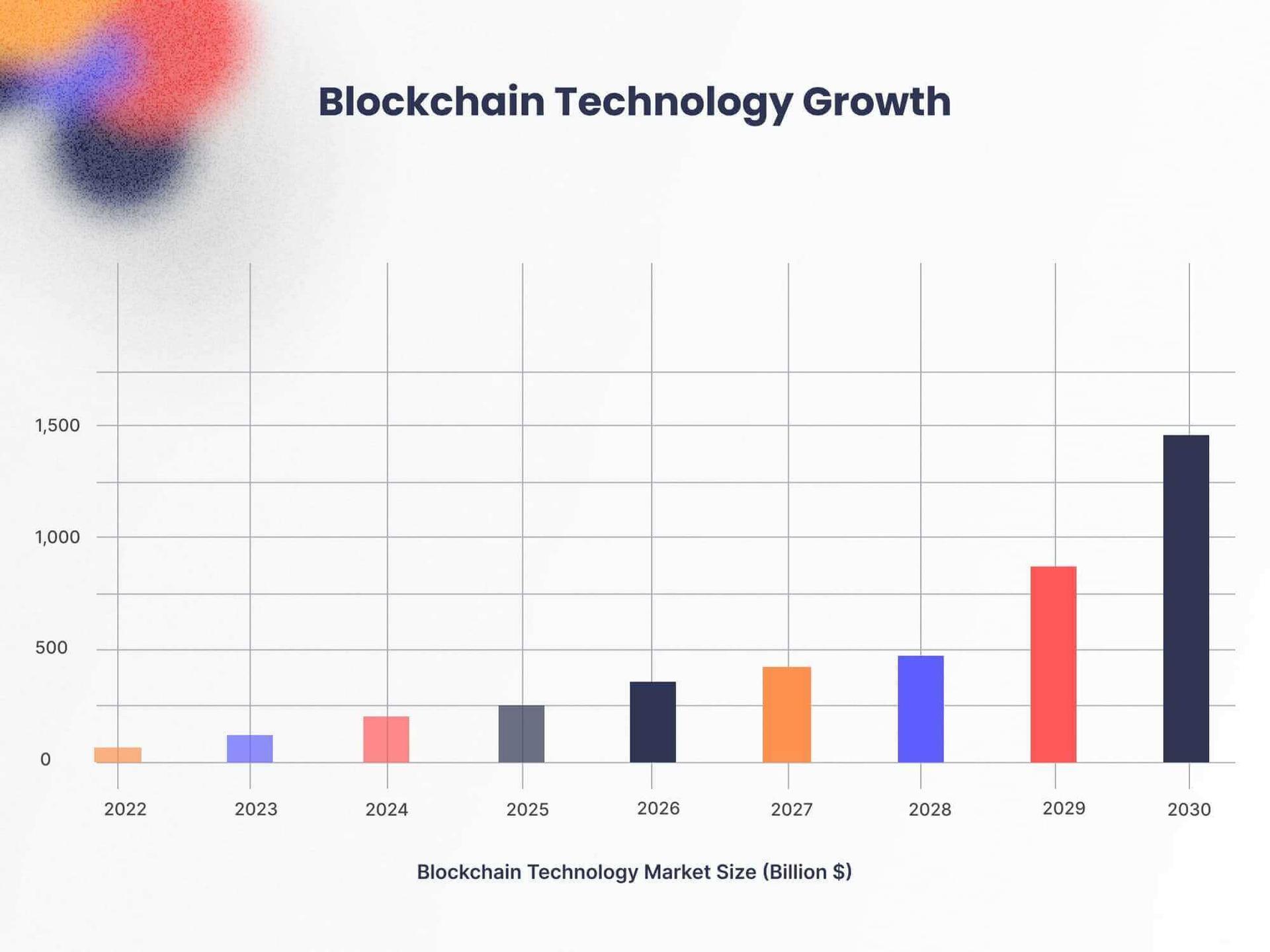
Source: blockchain talent is at a nascent stage, but growing 86% annually
Source: blockchain technology market size is projected to grow for $7.19 billion to $163.83 billion in 2030
1.2 Social
There has been a significant rise of remote and freelance work, especially in the software engineering sector. The industry accepts the notion that it does not matter where the developer is physically located, either home, office or elsewhere around the globe, as long as they deliver quality work. Also, the nature of the work becomes more project-based which favors freelancers more than full-time employees.
Source: 51% of software developers went remote in 2021.
2. The Problem
2.1 Unsupported Talent Pool
The current supply of Web3 talent is low, either because the talent is undiscovered or unsupported. Blockchain employs different technology than conventional systems because it is designed to be distributed and decentralized. Blockchain technology uses cryptographic primitives such as secure hash function, elliptic curve digital signature algorithm, Merkle Patricia Trie storage model, etc. These technologies are unfamiliar to most software developers and they need time and a place to learn the knowledge. Unfortunately, since there is no place to learn or get started with Web3 projects, the short supply will persist for a while.
There is a wide range of workforce categories needed to build the Web3 ecosystem. An example of these categories includes: software engineers, growth marketers, business developers, product managers, data analysts, operation managers, designers, finance, legal, and resource specialists. We refer to these categories as Web3 talents.
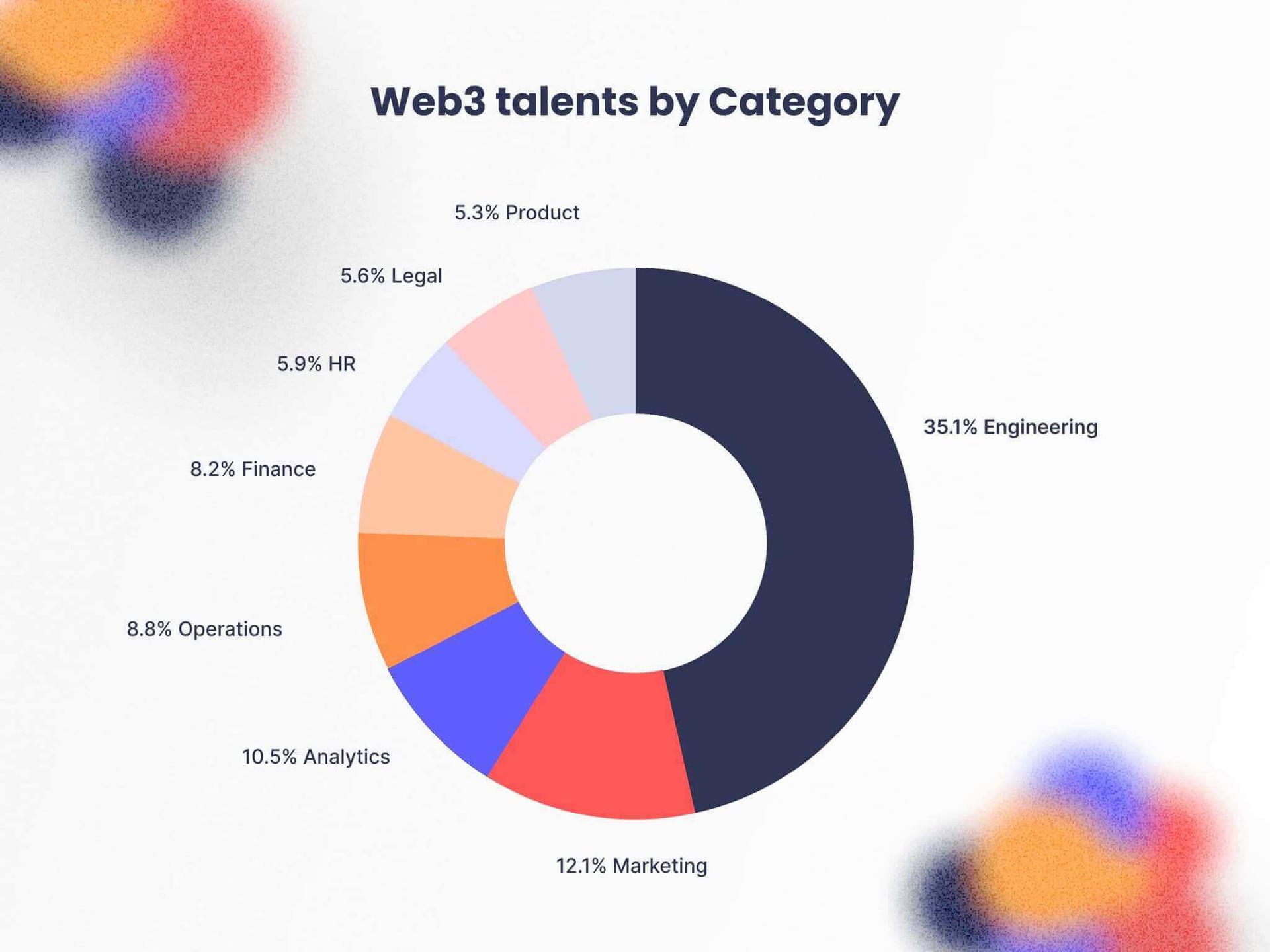
Source: crypto job market statistics
Source: the demand for web3 talents is never greater, but the challenge is on the supply side
2.2 Double-sided Inefficiencies
There is not a dedicated Web3 job marketplace at a scale that lets companies find qualified talents and where talents find legitimate companies at ease. Companies are struggling to find qualified talent, spending weeks, if not months, searching without results. On the other side, talents are getting frustrated trying to find remote opportunities, often getting lost on site-specific job postings or in niche job boards without getting noticed.
2.3 Hiring 2.0 vs. 3.0
Most talent seekers will resort to a resume to evaluate the talent’s qualifications. While a resume gives perspective, it is subjective and one-sided. Companies looking to hire have to resort to additional skill tests to avoid a skill mismatch. These traditional hiring practices can be insufficient and cumbersome. Blockchain and wallet-based vetting mechanisms that allow companies to evaluate talent promptly and reliably before the interview step can minimize the risk of a wrong hire.
2.4 Nonexistent Ownership & Community
The lack of ownership and community is causing a prominent inefficiency for hiring professionals and talents. Currently, the most common option is niche job boards where people can submit applications, get contracted, interviewed, and hired (or not). This process is event-based and does not allow for talent to gain value from the process, or to own their experience from begin to end. Talents are traveling from site to site without a clear direction.
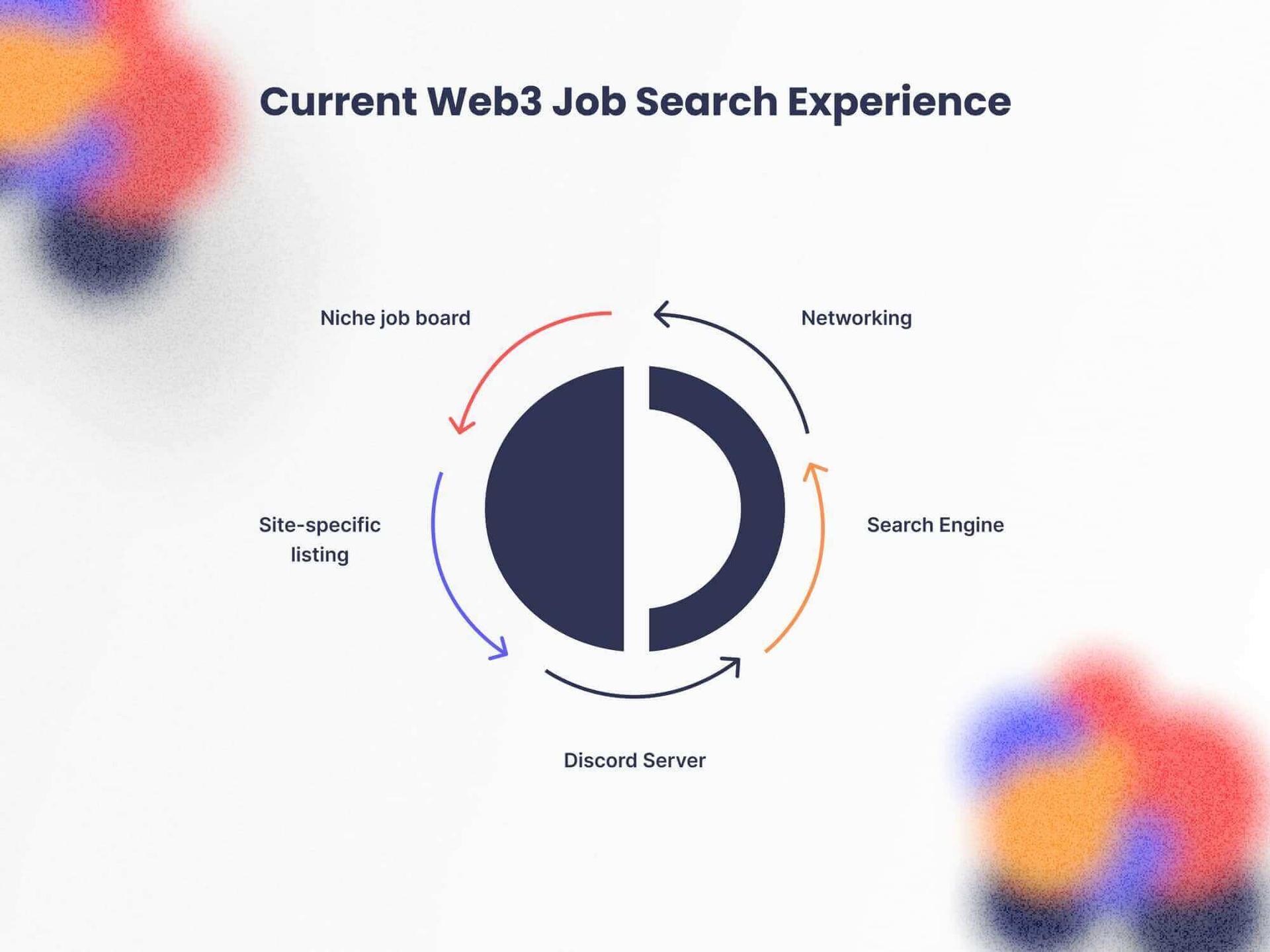
Talents are the core asset in which a job marketplace builds its entire business, yet the talents have no say in the community they help create. Therefore they do not have any interest in the network and act merely as transactional items for the network. The lack of community leaves a huge loss of value for the network and the marketplace.
Some niche job marketplaces networks were created in an attempt to solve this inefficiency, but they are typically very small, and inactive. Only the top 10% of talents get hired regardless of which network they join, while 90% of talents are left behind. In other words, there is no value or community created for talent.
The net effect of all the inefficiencies is a great loss of value for the talent. Lengthy, costly, unreliable, and unclear hiring processes make it difficult for talent and companies to efficiently find each other. Due to the inefficiency of the job board, companies have to rely on an extra layer of intermediary, such as a recruiting agency, to manually search for talent to fill an open vacancy and charge upwards of 45% of the talent’s salary for the service.
3. The Solution
We propose Outdefine, a decentralized, talent-first hiring community and job marketplace backed by its native token. The community will focus on the Web3 paradigm and will achieve a network effect on hiring so Web3 talents and jobs are effectively matched. The community will be member-governed, and operated, and its members will transform into community stakeholders by earning tokens as a reflection of their contribution to the growth of the community.
3.1 Corners of Community
There must be a place for Web3 hiring to overcome the current absence of such a proposed community. To fill the voids that are currently present in an industry lacking ownership and community, these guiding corners are necessary:
a. A dependable place for Web3 learning b. Authentic community for Web3 talent to generate ideas and discuss shared interests c. A reliable space where Web3 talent and other users are the stakeholders and governors d. Supportive systems that generate value and rewards for Web3 talent and hiring professionals
3.2 Trusted Talent
Trusted talent is one pillar of our proposition. We see a major inefficiency in finding quality talent, due to the fact that the talent pool is widely unvetted and talent seekers have unreliable means to gauge the talent’s capabilities. To transform to the new paradigm of higher efficiency and reliability there is a need for vetting standards. We envision a future where talent from all categories are trusted. For example, engineers can become trusted by taking a programming test, or marketers can become trusted by taking a digital marketing test and undergoing community driven in-person interviews. Another way to vet talent might include providing a certificate of formal training. We also value the vetting of soft skills such as sales, communications, and public relations via proof of education or professional training.
3.3 Community Governance
Community driven governance is another pillar of our value proposition. Talent and other users will govern the community they create. When considering a platform like Twitter, regular users do not have a say on how the network is run, nor do they control their accounts. Twitter has complete ownership and control over anyone’s account. In a Web3 paradigm you can earn any token on Ethereum without anyone’s permission. There is no central authority governing the approval of opening an account, and nobody has the power to revoke it or move it. For example, the Uniswap token (UNI) allows token owners to vote on important decisions like partnership proposals. The collective body of UNI holders have complete governance over the community and together make important decisions on the direction and affairs of the UNI economy. Because of the Web3 token holding mechanism, these privileges can not be extracted from token holders. This pillar of governance is a valuable benefit and incentive that makes the Outdefine ecosystem an appealing community for talent and other users to join.
3.4 Talent Centered
Outdefine leads with a talent-first vision where the supply and demand are directly met and transacted, all talent is trusted, and governance is in the hands of the members and other stakeholders. The community will help talent move from Web2 to Web3 technology, assist talent in finding Web3 jobs, provide opportunities for the community to attend Web3 events, form Web3 startups, and provide meaningful work for talent. Such a community will largely eliminate the current market inefficiencies and establish a standard for an effective, transparent, trustworthy, and low-cost platform for talent and other users.
4. Technology
Web3 and blockchain adopts some interesting technologies that make the new business paradigm possible.
4.1 Append-only & Immutability
First, blockchain employs an append-only database, which writes the data with a digest and secure hash function. This means that users cannot overwrite or delete the data. The cryptographic digest will also be modified if the data is modified. This provides an excellent audit trail of any data people add to the blockchain.
In the context of a talent network, append-only and immutability provide a convenient way to log a talent's career path and achievement as we write them into a blockchain: where and when a talent received their education, which company they worked for, what skills they learned, what type of work they performed, etc. Upon verification of these documents, we can write them into a smart contract, and even mint an NFT with metadata representing these milestones. The next time a talent is seeking a job, they just need to prove ownership of the NFT, and the new employer will see all the previous experience and gain a reliable view of the talent’s fitness for the job.
4.2 Verifiability
Next, we have the notion of verifiability. Every transaction is monitored by many distributed nodes, and every transaction is verified that the sender has enough balance and that the cryptographic signature is indeed from the sender. You don't just "trust" each transaction, you verify it. With the creation of a talent community, we can translate the talent's educational, skill, and work histories into verifiable on-chain non-fungible tokens (NFTs) minted to their wallets. Talents sign a transaction proving that they are the owner of the token that contains all of their skill credentials.
4.3 Personal Privacy
The NFT can be enhanced by adding another layer of privacy, for example, encrypting all the educational and work history so the public is not able to view the clear text, only the owner is allowed to reveal the information to a specific verifier with a one-time decryption key.
4.4 Foundational Vetting
A talent must fill out their work-related information, including education and work history, when signing up on the platform. Upon initializing a vetting process, the community can allow the talent to submit corresponding documents such as graduation certificate, employer confirmation letter, Java programming test result, etc. Once the community collects satisfactory documents, it will organize the information into the metadata for an NFT, which includes the link to the official document, then invoke a smart contract call to mint an NFT, or multiple NFTs each representing a different credential for the talent. The talent can then sign a message from their wallet to show the potential employer their NFT, as well as their ownership of the NFT.
4.5 The Rise of the DAO
Next comes the notion of community and DAO (decentralized autonomous organization). A prominent example is that if you are an active participant of a community, such as a proof-of-work miner in Bitcoin or Ethereum, you will receive Bitcoin or Ethereum for your work, and have the opportunity to influence the project's future.
We would naturally build the network as a community and a DAO, where people who are most active, and who contribute the most to the community are rewarded with tokens. Our smart contract will mint tokens for various parties who contribute to the growth of the community, such as getting their skills vetted, getting a job, doing work, or finishing an online course. It will also mint tokens to recruiting agencies and affiliates who bring companies and talent into the community. Companies can also access the hiring network by holding the tokens.
The community will be governed by the token holders (stakeholders). Tokens will be awarded first to members who contribute the most. The stakeholders will be able to propose, vote, close, and execute any initiative using a governance contract on the Polygon blockchain. In the event that the community receives a business proposal, it will not be decided by a few people behind closed doors, but rather by placing the proposal on the community forum, where members can evaluate it, discuss it, and vote on it using both off-chain and on-chain governance mechanisms.
4.6 Tokens and Smart Contracts
Next comes the notion of tokens and smart contracts on a blockchain. Using smart contracts, a talent network can mint its own token and send it to its members according to specific rules. By integrating smart contracts into frontend and backend tech stacks, user experience, incentives, and governance will be aligned. Community members can earn tokens automatically upon completing certain tasks. As a result, early adopters will earn more tokens per action.
4.7 Tokenization
With the new technology, each talent can be vetted individually, each credential can be recorded as a verifiable and immutable record on a blockchain, and the talents can still prove convincingly that they possess the skills while maintaining their privacy through encryption or zero-knowledge proof techniques. As a result, the information is reliable, saving time, money, and potential mistakes in hiring. We can also "tokenize everything", such as an educational credentials and employment records using non-fungible tokens (NFTs). Job postings can also be tokenized, for example, by issuing NFTs containing all the necessary information, and by defining bid actions within the smart contract for each application. During the hiring process, the NFT bidding can be closed and the winning talent will be the one selected, according to the smart contract terms. More generally, a person’s time can be sliced and tokenized as an NFT or fungible token (FT) and be traded on the market. We envision a world where human resources are tokenized per person and per hour as FTs or NFTs and traded on the marketplace.
5.Business Model
The primary function of our business model is to build a decentralized community around Web3 talent, in part through a job marketplace, but also through learning, events, and grants.
5.1 Web3 Talent Paradigm
Firstly, we aim to build an effective web3 job marketplace where talent and employers can connect efficiently. A thorough vetting process is used to ensure the hiring process is efficient and reliable to ensure no surprises arise during the employment process. Talent will directly invoice the company for their work and keep 100% of their pay. On top of their salary payments, talent will also earn community tokens. Community members will adopt the freemium model, which is mostly free and earns revenue by marking up 15% on talent invoices.
All talents will be vetted, in contrast to the existing model, where talent is mostly unvetted, thus its capability is unmeasured and can vary widely. This creates uncertainty for hiring and can be a waste of time for both parties. Our business model strives to eliminate uncertainty and introduce reliability and efficiency into the process.
The community’s 15% contingency fee, charged on successful hiring and work performed, is moderate in contrast to the existing model where the fee is often between 35% - 45% and can come directly from the talent’s earnings.
5.2 Learning Pathways
A natural extension of our business model is to help developers transform from Web2 to Web3 technology. To help our talents learn Web3 through hands-on training, we will make various courses, live lectures, and live interviews with industrial experts. We will initially select courses, but eventually we envision a decentralized learning marketplace where talents offer training to others and may charge fees in tokens. Each course will be managed by the community as a whole, and decisions will be made by voting.
To ensure the quality of education, learners will need to pass exams or accomplish projects in order to acquire the completion certificate. The talents who completed the course will have a better chance to find Web3 jobs, especially when the program is operated by and for a specific Web3 ecosystem, as many blockchain ecosystems have a strong desire to advocate their ecosystem to the developer community. We can imagine a training course initiated by the Outdefine community but funded by Web3 foundations.
5.3 Hybrid Events
Events will be held both virtually and physically as the community grows. In these events, researchers, engineers, and business people will network and learn together about a niche market or a niche interest. As new technologies emerge every day in the blockchain space, we see an opportunity to specialize in several topics and blockchain sub-categories and become the leading event host. This will greatly help achieve a network effect so more talents and companies will be attracted to the the community.
5.4 Incubator
The next business model is the idea incubation and startup formation from our talent network, our talents are the people who develop web3 technology hands-on, they know it the best. They are the front line workers who are prone to generate great ideas and have a strong desire to make them real, a couple of them may end up being great entrepreneurs making the next unicorn . We see huge potential incubating ideas within our network and use our token to provide early funding and grants to a selected participants.
5.5 User Bounties
As a reward for users who develop challenging, advanced tasks, the next business model offers a development bounty. Additionally, users can earn bounties for identifying and bringing together talented researchers and engineers and introducing them to corresponding enterprises, implementing research papers, evaluating a new sharding proposal, or benchmarking of new consensus protocols. Taking the lead in fostering the research and development of Web3 projects early will result in great financial returns for all parties, including researchers, engineers, enterprises, and us, the Outdefine community.
5.6 Token-powered
Tokenization plays a crucial role in our business model. Our talents and their skills are our most valuable assets, and we will tokenize them at the atomic level. Each skill set, for example, is tokenized. More token rewards will go to those who are vetted, work on the platform, and contribute to the community. Referrers who bring talents or companies to the platform follow a similar principle. You will receive more tokens if you refer more people. In addition, people will be paid in tokens when they are approved for community bounty projects. Token holders can stake their tokens to earn interest, or stake to govern community affairs.
To participate in our premium services, such as learning courses, incubation events, and startup launchpads, participants will need to either prove their token staking or spend tokens. Our paid programs can be paid with USD or our token. When paying in tokens, payers will receive a discount. The "discount if paid by token" principle will apply to all categories where we charge a fee. For example, companies will receive a discount if they pay the 15% network fee using our token.
There are a number of capabilities built into the native token. For instance, acquiring, holding, staking, governance, and spending. Additionally, tokens can be exchanged for valuable services provided by the community. With a growing and active community, we expect to be on the path to establishing a healthy token circulation with a growing token value.
After the token launch, the platform will commit a portion of its revenue to buy back tokens from the open market and burn or store them in the treasury. Our expectation is that the buying power of the community will increase as the community becomes more popular.
5.7 Dynamic and Buildable Ecosystem
An open, self governed community on which everybody can develop applications is an important part of our business model.
We talked a lot about what business model Outdefine will build, and while we will surely spearhead key implementations from each business model, the intention is that the community will build and execute them. Each user, external team, and internal team is able to, and encouraged to build their business on top of the platform and token. Here are several possibilities for what you can be done:
- Operate a recruiting agency
- Provide training programs to the community
- Offer bounty programs for
- Software development
- Security auditing
- Implementing research papers
- Building proof of concept systems
- Host events
- Recruit founding teams
- Offer vetting services
- Build value-added solutions such as
- Privacy solutions
- Zero-knowledge proof
- Chain to chain bridge for token swaping
With our token, there are no limits to what people can do, provided that we build a large, active, engaging community.
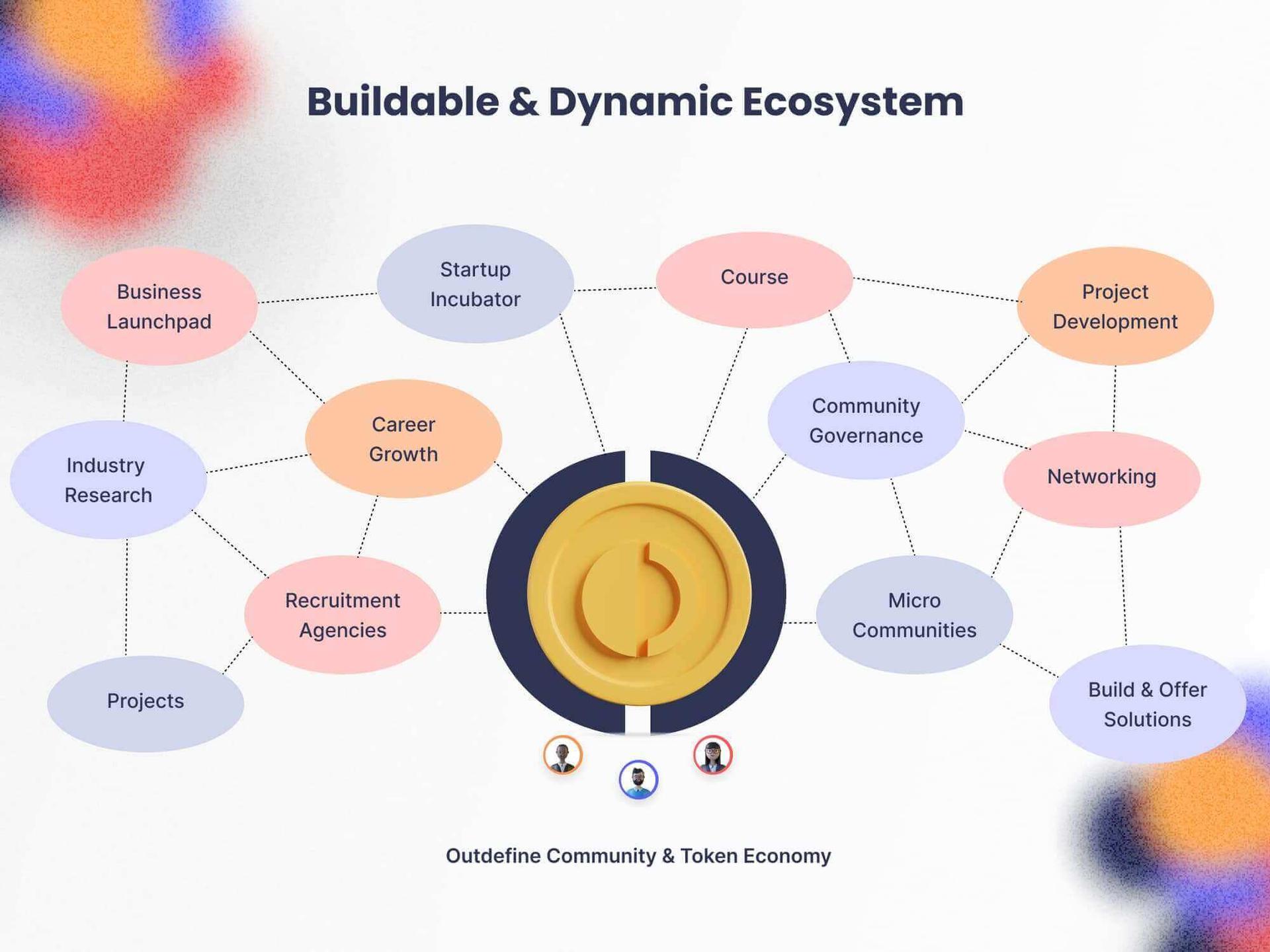
6. Team
CEO and co-founder Romil Verma formerly co-founded a venture-backed company and worked as an engineer at Google. He began his blockchain career at Stanford in 2014 when the overwhelming majority of people were diving into artificial intelligence. Across his various roles, Romil saw that the options available to hire great talent lacked the necessary trust and transparency between companies, talent, and hiring networks.
Romil has partnered with co-founder and CRO Sanjay Verma, who served as CXO for several public engineering services companies over the last decade. Sanjay has led such companies through growth, mergers, and geographical expansion while managing 25,000 people globally.
7. Growth Strategy
To reach critical mass and achieve a network effect, business development and marketing are vital. An abundance of trusted talent, for example, attracts more companies and recruiters to join the community and hire folks. In addition to traditional marketing, we emphasize on decentralized growth. The community driven grow is crucial, and from there we will launch three unique programs:
- Web3 job aggregation
- Recruiter ecosystem
- Referral program
7.1 Web3 Job Aggregation
Our first step is to aggregate all web3 jobs to our application, so we are the one place for all web3 job listings even though they are not from our direct clients. Such a place doesn’t exist yet, doing it will create some value and help build brand awareness, also help attract web3 job seekers and convert some to our network.
7.2 Recruiter Ecosystem
We will allow the recruiting agencies to contact our talents in the community to respond to the company’s hiring request, and earn a token reward and recurring revenue share, in exchange for talent invoicing the client on the platform. Our account executives will actively reach out to recruiting agency with our value proposition.
7.3 Referral Program
Our next strategy is to launch referral programs that reward those who refer talent or companies to our community. A certain amount of tokens and revenue share will be awarded to the referrer for each successful hire they refer. As part of our referral program, we will pitch our program to social media influencers in the crypto space in order to convert their audiences. Additionally, we will promote our referral program in some niche developer forums, tech talks, and blockchain ecosystems.
With our efforts to promote our message across the globe, an incentivized onboarding process, an incentivized referral program, a network of quality, vetted talent and a community of job seekers and talent seekers, we anticipate creating a powerful word-of-mouth effect that will amplify our growth.
8. Tokenomics
Initially, we plan to mint 1 billion tokens on Polygon, which may later deploy to multiple chains.
Polygon is chosen as our initial launch chain because of its high transaction throughput, low transaction fee, and instant finality, which makes it a good fit for integrating the business logic of our talent community. The Polygon ecosystem also has a large and active user base with many developers, so we expect to convert developers in the Polygon ecosystem to our community.
We will examine other blockchain ecosystems and potentially launch our token there, depending on the synergy we discover. Our vision is to make our token available across all major blockchain systems, today and in the future.
A total of 50% of the token supply will be allocated to the community. Allocation will be determined by the user's actions (vetted, hired, doing work) and their contributions to the community. We expect it to take 5-7 years to fully allocate the tokens to the community.
The remaining 50% will be allocated to the corporate treasury, for the team, investors, advisors, and public sales pool that are subject to linear vesting cliffs.
We will also employ a decaying rate of token allocation overtime, so our early adopters and community members will get a greater proportion of the allocation.
Below is an overview of the token distribution:
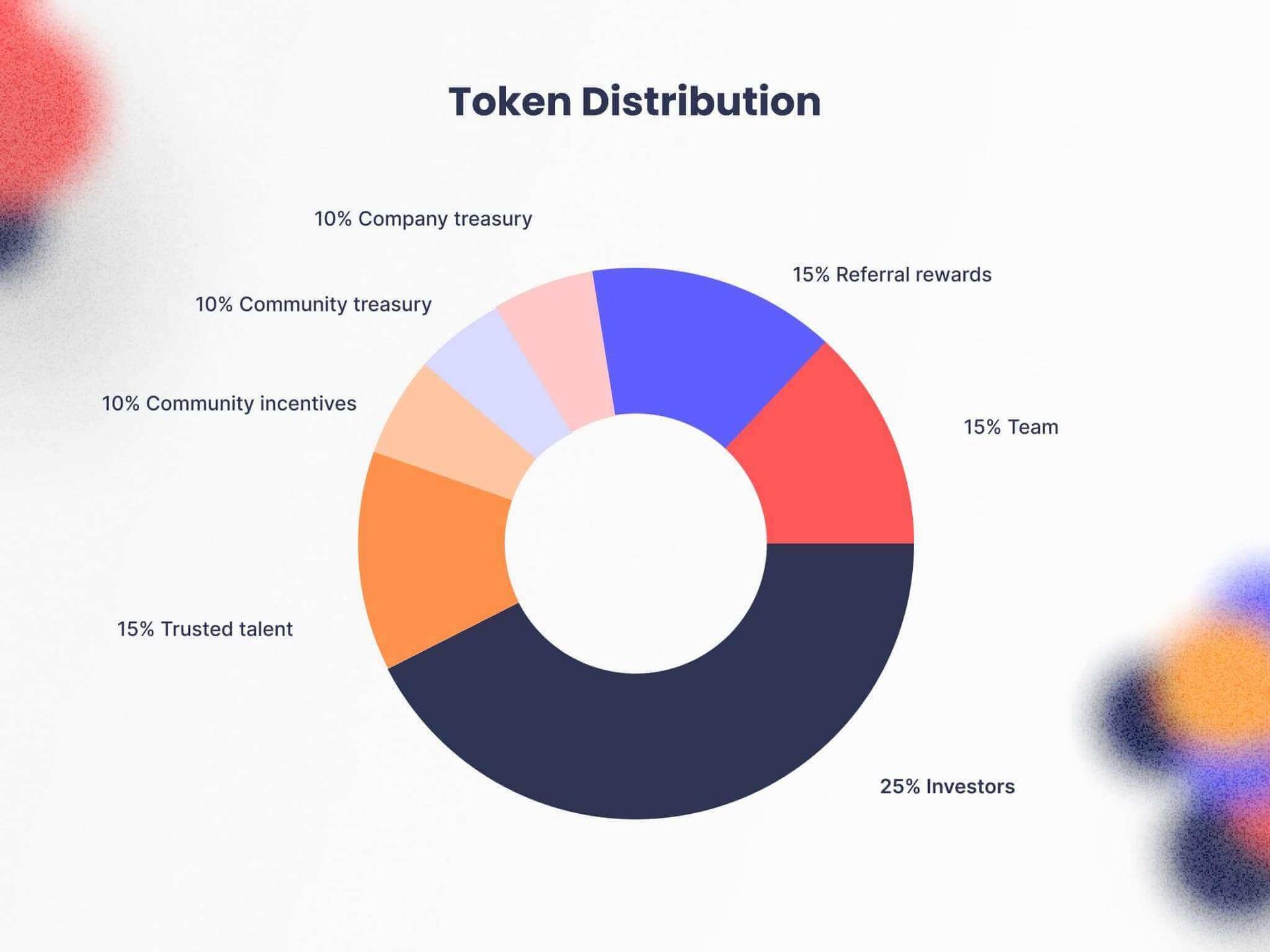
9. Roadmap
Our roadmap reflects our vision to cultivate a community that will grow and evolve together. The community will thrive in having opportunities for everyone to define their experience and careers.
- Q4 2022
- Launch decentralized talent community app
- Publish whitepaper
- Issue token rewards on testnet
- Q2 2023
- Launch talent referral programs
- Integrate the marketplace with the smart contracts
- Q4 2023
- Launch community incentive programs
- Launch ecosystem referral programs
- 2024
- Launch on mainnet
- Launch cross-chain token
This is a rough timeline, and is subject to change.
10. Disclaimer
The whitepaper is intended for general informational purposes only and does not constitute a prospectus, an offer document, an offer of securities, a solicitation for investment, or any offer to sell any product, item, or asset (whether digital or otherwise). The information herein may not be exhaustive and does not imply any elements of a contractual relationship. There is no assurance as to the accuracy or completeness of such information and no representation, warranty, or undertaking is or purported to be provided as to the accuracy or completeness of such information.
Where the whitepaper includes information that has been obtained from third-party sources, the Outdefine team has not independently verified the accuracy or completion of such information. Further, you acknowledge that circumstances may change and that the whitepaper may become outdated as a result; and Outdefine is under no obligation to update or correct this document in connection therewith.

